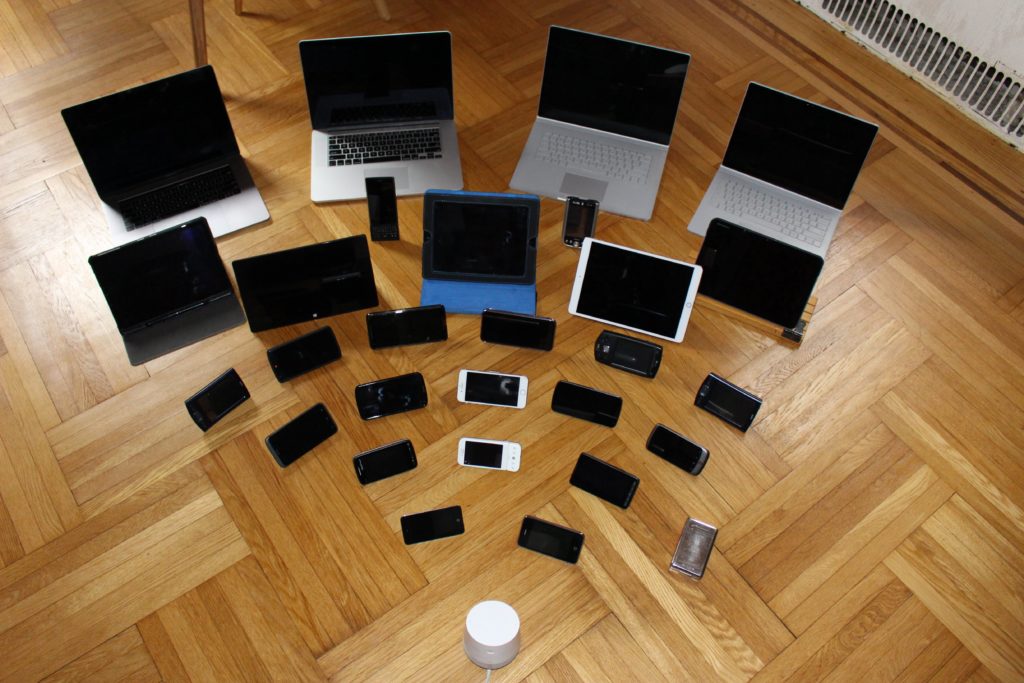“The coolest music video EVER…”
– David P Stearns, Philadelphia Inquirer
“…charmingly lo-fi and brilliantly inventive. And fun.”
– John Schaefer, WNYC
Filmed in a single take, this immersive walkthrough experience of John Luther Adams’s Ten Thousand Birds was conceived by Alan Pierson and performed by members of Alarm Will Sound on 27 different screens (many antique or obsolete) in Pierson’s apartment. From John Luther Adams: “This incarnation of Ten Thousand Birds touches me deeply. Not only because of the imaginative way my friends in Alarm Will Sound have recreated the music. But because of the intimate glimpse it gives us, in a time of crisis, into the streets of the city I love, and the irrepressible spirits of New Yorkers. It’s more important than ever for us to remember our connections with the larger-than-human world, and to celebrate the never-ending music of this miraculous planet that is our one and only home.”
Each screen shows a member of AWS performing their part (each musician plays the song of a bird native to or migrating through New York City, as well as sounds of wind and frogs). Alan designed a path through the installation, and filmed the synchrony in a single 5-minute take.
The 27 screen devices that he corralled include obsolete, early aughts gear like iPods and PalmPilots, and antique handhelds that he has collected over the years. With the help of his boyfriend, software engineer Paul Melnikow, Alan spent countless hours fashioning the devices into a DIY installation. The setup called for rifling through closets and unpacking boxes to find old hardware, investigating legacy codecs, and learning how to use ancient and malfunctioning hardware.
Alarm Will Sound’s Executive Director Gavin Chuck sees this project in relation to the special responsibility now of creators and organizations who make contemporary art. “More than ever, Alarm Will Sound is leaning into experimentation. A profound impact of the pandemic is uncertainty. But instead of merely dealing with it, imagination is a potent way to overcome uncertainty. When nobody knows what’s next, artists can and should imagine what’s next.”
In the words of Alan Pierson: “This project is about longing for the kind of community and connection to the outdoors that Adams’s music is all about. It’s also about re-discovering the richness of what we’ve actually got on hand.”
Watch a behind-the-scenes video about the creation of Ten Thousand Birds/Ten Thousand Screens here.
![]()
“Outside my window, low-flying copters with squads of men in their doors roared over the rooftops. A parade of masked marchers advanced on the empty street below, chanting in response to the call of a lone megaphone. A string section of sirens howled up from Dupont Circle a few blocks away; another came from deep downtown, their cries scrambling together between the high-rises.
And up and down my street, the windows filled with the silhouettes of my neighbors, backlit by their living rooms. It looked like a vast grid of screens, each of us stuck at home in the same virtual space, craning our necks to the sky. Our sudden visibility felt like a language. Our fear felt social.
Sound has a way of binding those within its reach together. Months ago, this might have meant a concert in a hall. But lately, it’s the ugly new music of the everyday — the dull roar of circling helicopters, the peal of sirens, the echo of explosions. And, come morning, the eerie quiet of quarantine, the dominance of birdsong.”
Michael Brodeur of the Washington Post reflects on Ten Thousand Birds / Ten Thousand Screens. Read the entire story here.
 The Devices and Stories Behind Them
The Devices and Stories Behind Them
Notes by Alan Pierson
Apple iPod Touch: This was my mom’s smartphone training device. She donated it to the Ten Thousand Screens project.
Google Nexus 4: This was my ex’s smartphone. He donated it to the “museum of handheld devices” that I was gathering when we were together.
Galaxy Nexus: This was the first Android device that was actually delightful to use, but it wasn’t available on my carrier in the States, so I had to go through shenanigans to get one from Europe. And then, like a week after it showed up, I dropped it while hiking in Arizona and cracked the screen and was very very sad.
Google Nexus 5: I thought this bright red phone was totally gorgeous when it first came out. I really wanted one but couldn’t justify buying it when I had a perfectly good phone already. When I saw one cheap on eBay many years later, I jumped at it.
HTC HD2 (2009): This was an iconic device in the Windows Mobile community: a valiant effort at making a Microsoft phone that could survive in an iPhone world. It made a huge splash when it first launched in 2009, and it retained a passionate user base for many years after that. I remember ogling it in stores. I really wanted one at the time, but never bought one. Then got one cheap on eBay many years later.
Google Nexus One (2010): The first of Google’s Nexus devices, and another icon. I first saw this phone in the hands of our trombone player, Mike Clayville, and eventually bought one for myself.
Microsoft Surface Book: my laptop!
Samsung Galaxy Tab S4: my tablet!
Apple iPad 2: This old iPad was donated to the project by a dear friend of Alarm Will Sound’s in St. Louis.
Motorola Xoom (2011): This was the first tablet that Google put out into the world. It’s a complete mess, but it’s got an important place in history.
Pixel 2 XL (2017): my phone!
iPhone 8 (2017): This is Paul’s old phone. It was already pretty well beat up before this project. And … then I dropped it during a long rehearsal day. Now it’s really beat up. He was planning to sell it. But I’m not sure how realistic that is anymore.
HTC One X (2012): This is my dad’s old phone. He donated it to the project.
Dell Axim x51v (2005): This is my old Windows Mobile PDA, much loved. The first one of these I bought got stolen at LaGuardia Airport in 2007. I landed in Indianapolis and immediately found a new one on Craigslist.
Microsoft Surface RT (2012): This is Microsoft’s original tablet. My dad donated it to the project.
Palm T|X (2005): This Palm was much loved by my ex. He felt strongly that my “museum of handheld devices” needed one, and donated it.
Surface Book 2 (2017): This is the device I conduct off of.
MacBook Pro: This is Paul’s laptop.
MacBook Pro: Paul’s other laptop!
iPad Pro: This is Paul’s iPad.
Dell Venue Pro: I got this for my museum. Felt like I needed to have a Windows Phone in there.
HTC Dream (2008): the very very first Android device. Mine is a development model I bought on eBay.
iPod Classic (2005): This is Paul’s much, much loved iPod. It sadly died during the making of this video.
Touch Pro 2 (2009): my Dad’s old cellphone. Legendary for its awesome keyboard.
HTC P6500 (2008): my very first smartphone. I heard it was coming out in a leak a year before the release, and eagerly anticipated it that whole year: I wanted a smartphone that could store my entire document and music library, and nothing else existed at the time with enough storage. When it finally came out, it was released only in Europe and cost $950 online, but … I bought it anyway. It showed up the day of the 2008 Bang on a Can marathon.
Palm T|X (2005): My ex loved Palms so much that he bought this second one when the first went wiggy.
iPhone 3GS (2009): My mom’s first iPhone, donated by her to this project.

